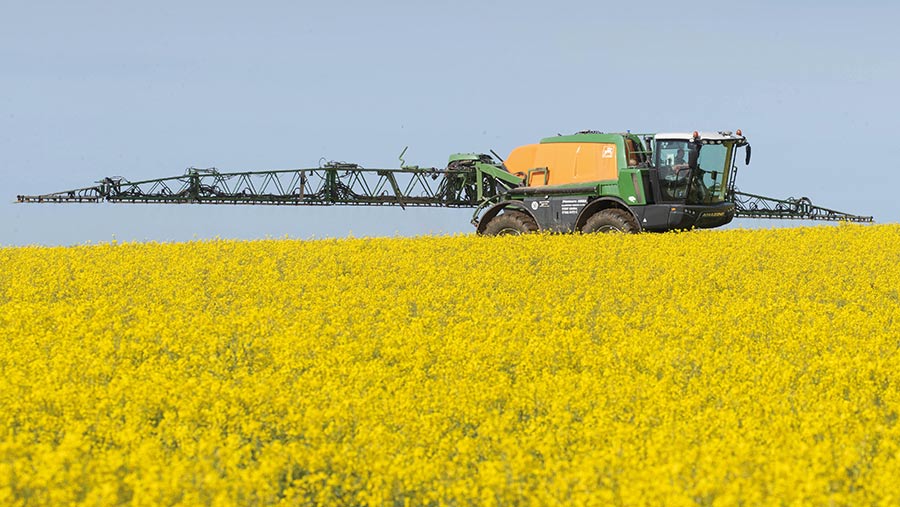Crop Watch: Good crop potential despite lack of April rain
 © Tim Scrivener
© Tim Scrivener Maize drilling has started in the South West, although soils are barely warm enough. The lack of rain is also a concern, as looks like a repeat of last year’s weather pattern.
Despite the dry weather, oilseed rape growers are being urged not to trim back on their flowering sprays to prevent sclerotinia, given the curent strong rapeseed prices.
West
Giles Simpson
Pearce Seeds (Somerset)
As I write this we have a long spell of dry weather with another week of dry weather forecast. Although the days have been quite warm, the nights have been cold and frosts are forecast for this week.
Maize drilling has started, although soil temperatures are barely high enough, but seed-beds are very good, which will help. Pre-emergence sprays are being applied and can be anything from straight pendemethlin to a full-rate Wing P (pendemethlin + dimethenamid) depending on weed burden.
See also: Velcourt turns to weed hoeing to cut herbicide costs
I have a lot of customers who are never in any hurry to drill and they always seem to have excellent crops. I still think the crops that go in the ground and are up within seven days are the best as they never seem to take a check.
I don’t have any grown under plastic (sorry, film). Muck has been, or is being, applied to maize ground and it is noticeable how much more accurate everybody is being. I hope this continues as and when fertiliser prices reduce.
The winter barley looks well and awns are just appearing on the most forward crops. Brown rust has been an issue in some cases, probably down to spray application timings as some were delayed due to weather.
Wheat disease
Winter wheats have had a robust T1 even though disease is low at the moment, as we know in the South West how septoria can come back to bite you if you’re not careful.
Last year’s weather pattern in April was similar to this year and then it rained for a month and septoria was difficult to control, and with the forward prices, it’s a crop worth protecting. Wild oats have been dealt with in most cases.
On the whole, fertiliser applications have been slightly lower than usual for reasons we all know about.
Quite a lot of slurry has been used earlier on the wheat crops on my dairy farms and generally it looks as if it’s replaced an application of ammonium nitrate. There has been a lot of slurry analysed this year, which does help in recommending application rates.
Grass growth on the whole is lower than average for the time of year, some silage has been made already with farmers on the multicut system.
Yields look to have been reasonable, let’s hope the quality is so they can reduce their bought-in feed bill next winter.
North
Patrick Stephenson
AICC (Yorkshire)
Up to date, we have had a very kind spring and drilling conditions have been near perfect. This has enabled most field work to be carried out in a timely manner.
In the UK we are blessed that our climate, although variable, does lead to a harvest. At this stage, crops look full of promise, but as 2012 taught us, nothing is guaranteed until the crops are in the shed.
Winter barley crops have won the race to be the most advanced, with many crops now having flag leaf fully emerged. Second growth regulators are now being applied with a holding fungicide spray.
I plan a three-spray fungicide programme for most crops, but this is often reduced to a standard two spray as timings come under pressure.
At this stage, black spotting is often confused with ramularia. If you examine these spots and look for the five R’s (see the AHDB guide), you will see that they are not consistent with ramularia. Spring barley crops are in varying states of emergence and establishment.
Early-drilled crops will be due a herbicide and potentially a fungicide. In terms of disease control, I treat early-drilled crops as higher risk and greater reward looking at a two-spray approach. The late-drilled crops are managed much more on a wait-and-see basis.
Winter wheat crops are staying “on time” and T1 sprays will now be applied. At the risk of giving the wrong message, I would suggest being slightly late with T1 is better than being too early.
Yellow rust is active, but has failed to ignite, but there is certainly enough inoculum around for me to keep ”trigger” happy with curative chemistry. The dry weather has meant the options for products at T1 has remained open.
Varieties with poor septoria ratings will have fluxapyroxad + mefentrifluconazole as their core treatment.
Flowering spray
If winter barley has won the 100m dash to flag leaf, then oilseed rape has taken the marathon for the longest period to full flower. We are already in an extended flowering period, but on a positive note the risk of sclerotinia has remained low.
Decisions on the use of pesticides are based on a risk of crop loss and reward of economic control basis. As potential crop values reach more than £800/t, then only a modest increase in yield justifies intervention.
Despite many people never having experienced sclerotinia, I think a full flowering spray is justified for the control of forgotten diseases such as alternaria and botrytis. My default position will be a full flower spray, which will centred on prothioconazole and bixafen.
It would be very easy to write a column on what insect pests we can no longer guarantee good control off in all crops, but oilseed rape has more than its fair share.
Another example of this is the control of seed weevil and pod midge. Areas of the Wolds have suffered severe damage in the past from these pests and control is based around the poor efficacy insecticides.
For most growers these pests are not a significant issue and treatment is not required. However, for known hotspots, monitoring headlands is the best way to track numbers and assess threat levels.
Flowering has just started in the winter beans with little or no disease present. I am trying to delay any fungicide application, if possible, to ensure we can have some cover in the later season.
It is my experience that the most crop loss is from later infections hence the delay in starting the programme.
Overall, the countryside looks resplendent, however, walking crops this week I fear a much uglier look in June.
South
Oliver Bennetts
Zantra (Kent)
Since my last article there has been barely any rain (but some heavy dews) locally, leading to some dry spring crop seed-beds. It’s starting to sound like a repeat of last spring with frosts and little rain.
However, crops are looking well and are growing steadily with the longer and sunnier days and are changing by the week.
Wheat crops in the area have either got their T1 or will be getting it soon based on mixes of azoles and SDHI fungicides looking to keep the leaves free from rust and septoria.
With few signs of disease in different wheat situations (date of drilling, variety…) this tends to show that the T0s along with the dry weather have been doing their job.
Keeping these lower leaves clean will be adding to final yield as well as allowing the crop to grow without the pressure from disease.
A plant growth regulator will be included in the T1 mix to help reduce lodging in the fast-growing crops – which could be a serious factor when all the N applied hits the system when we get some proper rain.
With winter barley crops really motoring, some crops are nearly at knee height already with flag leaves out, meaning the next fungicide and growth regulator application is just around the corner.
Spring crops
With the rain holding off and allowing cereal drilling to finish, crops are now through the ground and some early-drilled crops already beginning to tiller. A combination of residual herbicides and the weather mean crops are staying clean.
Peas and beans have either emerged or are starting to emerge with little pest damage from weevils, and their residual herbicides are keeping seed-beds clean. What they need now is just a bit of rain to really get going (but not as much as last year – fingers crossed).
Maize land has been cultivated and prepared over the past week, ready for planting to start over the next couple of weeks.
Potatoes in the area have been going in, and with planting nearing the end, beds are forming well. However, they will ideally need a rain to help settle them and aid the residual herbicides in covering the full bed. Earlies are just starting to emerge, especially those that were planted as pre-chitted tubers.
East
Marcus Mann
Frontier (Essex)
Dry Aprils feel like they are becoming the new normal, with very little rainfall recorded for the month to date and none in the forecast for the foreseeable future. That said, crops look remarkably well, with the longer, warmer days supporting rapid crop development.
While not wanting to mention the “D” word just yet, fingers crossed we get some rain in May to help deliver some of the excellent potential that is in the field. Field work has been progressing at pace, with only the nagging, easterly breeze over the past few days limiting the number of good spray days.
One crop that has certainly benefitted from the brighter weather has been winter oilseed rape, which is flowering nicely where pigeon damage is less present. Mid-flowering fungicides have been applied to protect the investment from the key flowering disease of sclerotinia.
Mid-flowering is also important to reduce the spread of light leaf spot up the plant, which increased in pressure since January. Now is also a time to begin to test nitrogen utilisation within the crops for the requirement of liquid nitrogen applications through products such as Nutrino Pro.
Winter barley
Winter wheat continues to show huge variation depending on varieties and drilling date and the timing to T1 fungicides has been particularly challenging.
It is important to keep in mind that septoria inoculum is hardly ever the limiting factor when it comes to disease severity.
While conditions in April have been less conducive to the spread of the disease to high leaf layers, we thought the same in 2021. Where product choice or rates were changed on the basis of a perceived lower risk, this proved to be costly mistake.
Given the current value of winter wheat, T1 recommendations have largely been based around mefentrifluconazole, to ensure we maintain a protectant situation ahead of the all-important T2 spray timing.
On the more susceptible varieties, yellow rust continues to be closely monitored. T0 treatments have worked well and allowed T1 sprays be well timed and targeted at leaf 3.
That said, the morning dews and warmer temperatures are conducive to the disease recycling very quickly. Depending on when leaf 1 is likely to emerge, the gap between T1 and T2 and developing disease pressure, a leaf 2 spray may be necessary.
Unfortunately, the dry conditions have meant pre-emergence herbicides have been less effective, with brassicae and polygonum weeds beginning to emerge in spring pulse crops.
Bentazone remains the only option after emergence in pulses, and with its limited activity on broad-leaved weeds, weigh up the compromise for weed control and potential crop damage, particularly while crops are struggling for moisture.
Winter beans are flowering and at present chocolate spot infections remain low. Current chemistry has limited ability to eradicate chocolate spot effectively so treat early to prevent spread.
In denser canopies, consider nozzles that will penetrate the canopy such as air induction nozzles like the Guardian Air.

